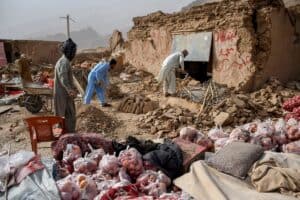On Saturday, Secretary-General Antonio Guterres said the rights of Afghan girls and women were being 'ripped away' in areas that the Taliban had already seized.

Aisha Khurram spent a sleepless first night under Taliban rule, the sound of gunfire and evacuation planes puncturing the silence as she reflected on a day that “shattered our souls and spirits to the core.”
“It was like a doomsday for the entire nation to see everything collapse in (the) blink of an eye,” she told AFP in a series of messages via Twitter on Monday after Taliban fighters swept into Kabul, and her neighbourhood, uncontested.
Khurram, a 22-year-old former youth representative to the United Nations, is just months away from graduating from Kabul University.
But she and fellow female students now face an uncertain future.
“The world and Afghan leaders failed the younger generation of Afghanistan in the cruellest way imaginable,” she said.
“It is a nightmare for educated women who envisioned a brighter future for themselves and generations to come.”
In the weeks leading up to their return to power, the Taliban’s leadership have strived to portray a softer image than when they last ruled Afghanistan between 1996 and 2001.
But women struggle to take comfort from such assurances.
– ‘History repeats itself’ –
Under the hardline version of sharia law that the Taliban imposed the last time they controlled the capital, women and girls were mostly denied education or employment.
Full face coverings became mandatory in public and they could not leave home without a male companion.
Public floggings and executions, including stoning for adultery, were carried out in city squares and stadiums.
The Taliban’s ouster did not spell the end of abuses. Women often remained marginalised, especially in rural areas.
But over the last two decades, significant progress was made in cities with women filling universities and entering the workforce in ambitious positions in the media, politics, the judiciary and even the security forces.
In the last 24 hours, prominent women in Kabul have taken to social media to express their pain for both a country and a way of life now that the Taliban are back in control.
“I start my day looking at empty streets of Kabul, horrified (for) its people,” wrote Fawzia Koofi, a rights activist and politician, and Afghanistan’s former deputy speaker of parliament.
“History repeats itself so quickly.”
“The fear just sits inside your chest like a black bird,” added Muska Dastageer, a lecturer at the American University of Afghanistan, which opened its doors five years after the Taliban were ousted.
“It opens its wings and you can’t breathe.”
– Broken hearts –
The Twitter timeline of Rada Akbar, a 33-year-old photographer, was littered with broken heart emojis.
“My beloved Afghanistan collapsed before my eyes,” one post read.
Another entry shared a now viral photograph of a man painting over pictures of smiling brides on the front of a hairdresser.
“Erasing women from the public space,” she wrote.
Akbar is known for her striking self-portraits that were both a declaration of her independence and heritage.
An exhibition she held earlier this year was forced online after she faced threats for her work showcasing some of the nation’s powerful female figures.
On Monday morning, her fear was palpable.
“I want to become invisible and hide from the world,” read her latest tweet.
Two days before the Taliban took power, the UN refugee agency was already warning that 80 percent of the nearly a quarter of a million Afghans forced to flee since the end of May are women and children.
On Saturday, Secretary-General Antonio Guterres said the rights of Afghan girls and women were being “ripped away” in areas that the Taliban had already seized.
Sahraa Karimi, one of Afghanistan’s most prominent women filmmakers, said she had no plans to leave.
“I will not abandon my country until the last moment,” she said in a video posted on Twitter, wiping away tears.
“Perhaps, many will think this is foolishness. But foolishness is what was done by those who abused our homeland… Foolishness is what the world showed by turning its back on us.”






